隨著時代的發展,IT企業也越來越多,相對應的ITEnterprises need more and more resources and assets.How to better pairitThese asset information within the enterprise are managed,This is a problem that many companies are concerned about.本系統從實際情況出發,The system is divided into two modules: administrator and employee,Mainly realizes the personal center employee information management.設備信息管理,borrowing of equipment,歸還管理,附屬服務管理,外包服務管理.軟件信息管理,Software domain management,配件信息管理,配件領用管理.配件歸還管理,Delivery of office supplies,Inventory and receipt management, etc.These functions can basically meet the needs of an enterprise's asset management.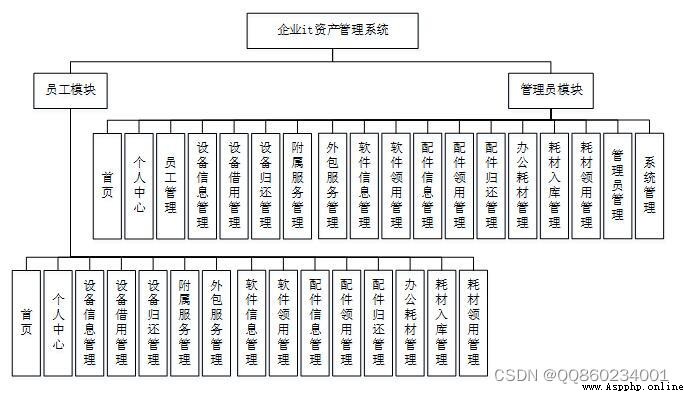
(1)管理員功能需求
管理員登陸後,主要模塊包括首頁,個人中心,員工管理,設備信息管理,設備借用管理,設備歸還管理,附屬服務管理,外包服務管理,軟件信息管理,軟件領用管理,配件信息管理,配件領用管理,配件歸還管理,辦公耗材管理,耗材入庫管理,耗材領用管理,管理員管理,系統管理等功能.
(2)員工功能需求
員工登陸後,主要包括首頁,個人中心,設備信息管理,設備借用管理,設備歸還管理,附屬服務管理,外包服務管理,軟件信息管理,軟件領用管理,配件信息管理,配件領用管理,配件歸還管理,辦公耗材管理,耗材入庫管理,Consumables management and other functions.
計算機畢業設計Python+djang企業it資產管理系統(源碼+系統+mysql數據庫+Lw文檔)
開發語言:Python
python框架:django
軟件版本:python3.7/python3.8
數據庫:mysql 5.7或更高版本
數據庫工具:Navicat11
開發軟件:PyCharm/vs code
前端框架:vue.js
可開發框架:ssm/Springboot/vue/python/PHP/小程序/安卓均可開發
This interface is the login interface,System administrators and employees can log in to the system through this interface,從而實現自己的功能.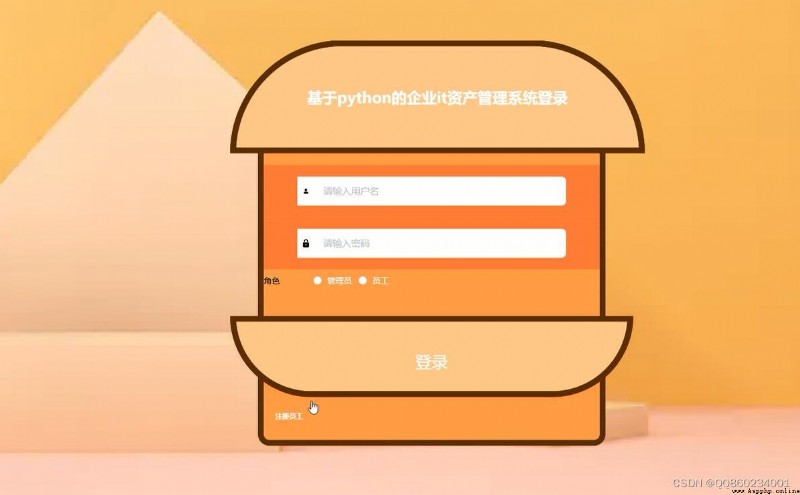
This interface mainly displays some asset equipment information within the enterprise,Include the ID of the asset,above the name of the asset.The type of image asset,數量,用途,The content of the precautions.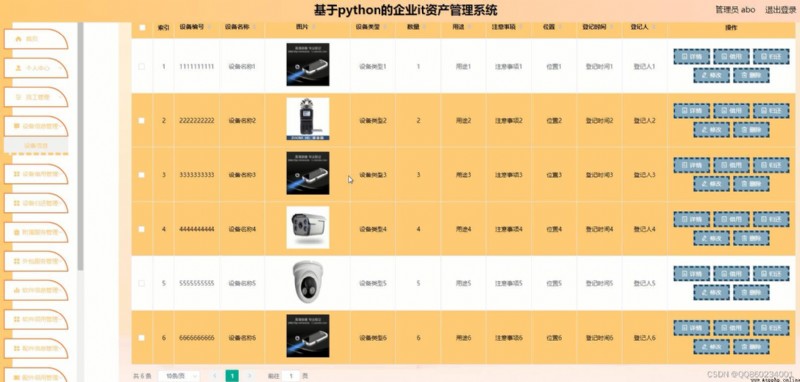
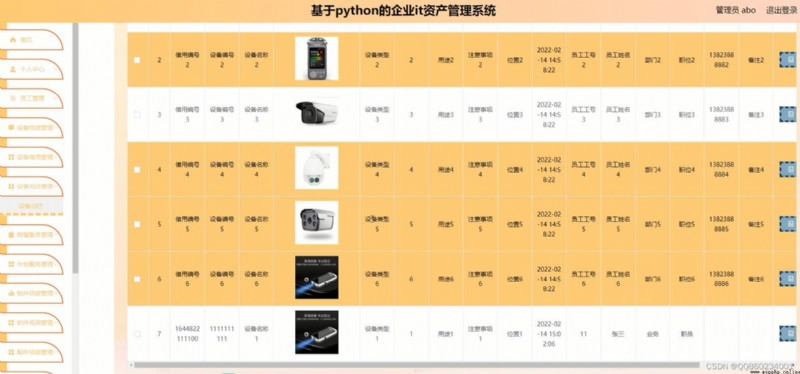
Managers can have access to all employees of this system class,用戶進行管理.The employee user mainly includes the employee ID,員工的姓名,部門,性別,職位,入職時間,聯系方式.頭像,The content of the ID number.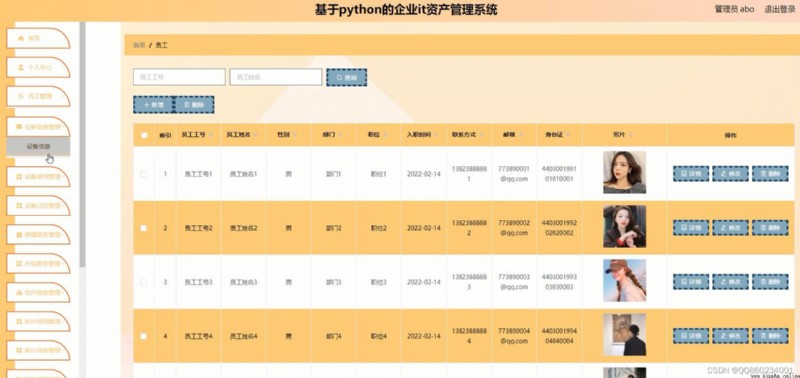
def haocairuku_register(request):
if request.method in ["POST", "GET"]:
msg = {
'code': normal_code, "msg": mes.normal_code}
req_dict = request.session.get("req_dict")
error = haocairuku.createbyreq(haocairuku, haocairuku, req_dict)
if error != None:
msg['code'] = crud_error_code
msg['msg'] = "用戶已存在,請勿重復注冊!"
return JsonResponse(msg)
def haocairuku_login(request):
if request.method in ["POST", "GET"]:
msg = {
'code': normal_code, "msg": mes.normal_code}
req_dict = request.session.get("req_dict")
datas = haocairuku.getbyparams(haocairuku, haocairuku, req_dict)
if not datas:
msg['code'] = password_error_code
msg['msg'] = mes.password_error_code
return JsonResponse(msg)
try:
__sfsh__= haocairuku.__sfsh__
except:
__sfsh__=None
if __sfsh__=='是':
if datas[0].get('sfsh')=='否':
msg['code']=other_code
msg['msg'] = "賬號已鎖定,請聯系管理員審核!"
return JsonResponse(msg)
req_dict['id'] = datas[0].get('id')
return Auth.authenticate(Auth, haocairuku, req_dict)
def haocairuku_logout(request):
if request.method in ["POST", "GET"]:
msg = {
"msg": "登出成功",
"code": 0
}
return JsonResponse(msg)
def haocairuku_resetPass(request):
'''
'''
if request.method in ["POST", "GET"]:
msg = {
"code": normal_code, "msg": mes.normal_code}
req_dict = request.session.get("req_dict")
columns= haocairuku.getallcolumn( haocairuku, haocairuku)
try:
__loginUserColumn__= haocairuku.__loginUserColumn__
except:
__loginUserColumn__=None
username=req_dict.get(list(req_dict.keys())[0])
if __loginUserColumn__:
username_str=__loginUserColumn__
else:
username_str=username
if 'mima' in columns:
password_str='mima'
else:
password_str='password'
init_pwd = '123456'
eval('''haocairuku.objects.filter({
}='{}').update({
}='{}')'''.format(username_str,username,password_str,init_pwd))
return JsonResponse(msg)
def haocairuku_session(request):
'''
'''
if request.method in ["POST", "GET"]:
msg = {
"code": normal_code,"msg": mes.normal_code, "data": {
}}
req_dict={
"id":request.session.get('params').get("id")}
msg['data'] = haocairuku.getbyparams(haocairuku, haocairuku, req_dict)[0]
return JsonResponse(msg)
def haocairuku_default(request):
if request.method in ["POST", "GET"]:
msg = {
"code": normal_code,"msg": mes.normal_code, "data": {
}}
req_dict = request.session.get("req_dict")
req_dict.update({
"isdefault":"是"})
data=haocairuku.getbyparams(haocairuku, haocairuku, req_dict)
if len(data)>0:
msg['data'] = data[0]
else:
msg['data'] = {
}
return JsonResponse(msg)
def haocairuku_page(request):
'''
'''
if request.method in ["POST", "GET"]:
msg = {
"code": normal_code, "msg": mes.normal_code, "data":{
"currPage":1,"totalPage":1,"total":1,"pageSize":10,"list":[]}}
req_dict = request.session.get("req_dict")
#獲取全部列名
columns= haocairuku.getallcolumn( haocairuku, haocairuku)
#當前登錄用戶所在表
tablename = request.session.get("tablename")
#authColumn=list(__authTables__.keys())[0]
#authTable=__authTables__.get(authColumn)
# if authTable==tablename:
#params = request.session.get("params")
#req_dict[authColumn]=params.get(authColumn)
'''__authSeparate__此屬性為真,params添加userid,後台只查詢個人數據'''
try:
__authSeparate__=haocairuku.__authSeparate__
except:
__authSeparate__=None
if __authSeparate__=="是":
tablename=request.session.get("tablename")
if tablename!="users" and 'userid' in columns:
try:
req_dict['userid']=request.session.get("params").get("id")
except:
pass
#當項目屬性hasMessage為”是”,生成系統自動生成留言板的表messages,同時該表的表屬性hasMessage也被設置為”是”,字段包括userid(用戶id),username(用戶名),content(留言內容),reply(回復)
#接口page需要區分權限,普通用戶查看自己的留言和回復記錄,管理員查看所有的留言和回復記錄
try:
__hasMessage__=haocairuku.__hasMessage__
except:
__hasMessage__=None
if __hasMessage__=="是":
tablename=request.session.get("tablename")
if tablename!="users":
req_dict["userid"]=request.session.get("params").get("id")